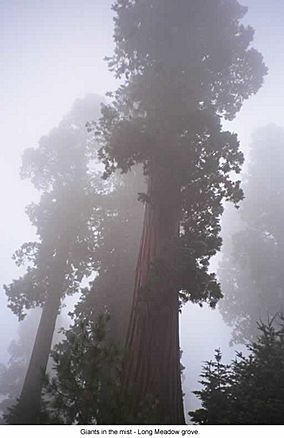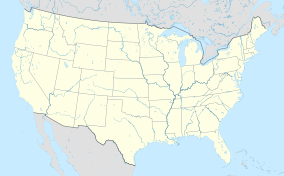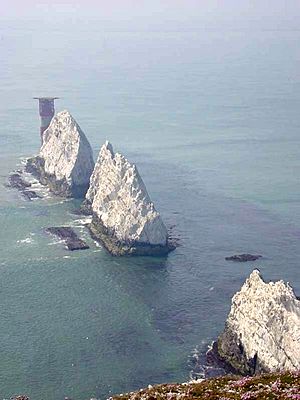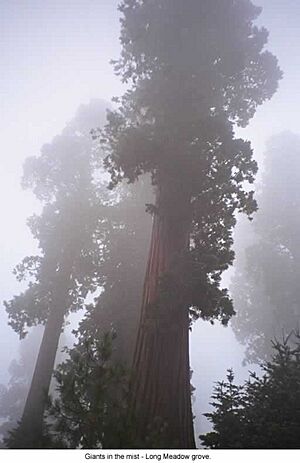Sequoia National Forest facts for kids
Quick facts for kids Sequoia National Forest |
|
|---|---|

Long Meadow Grove on a misty day
|
|
| Location | Tulare / Kern / Fresno counties, California, US |
| Nearest city | Bakersfield, CA / Porterville, CA / |
| Area | 1,193,315 acres (4,829.17 km2) |
| Established | 1908 |
| Governing body | U.S. Forest Service |
| Website | Sequoia National Forest |
The Sequoia National Forest is a large forest area in the southern Sierra Nevada mountains of California. It is named after the amazing Giant Sequoia trees. These huge trees grow in 38 special groups, called groves, within the forest.
Inside the forest, you'll also find the Giant Sequoia National Monument. Other cool features include landscapes shaped by glaciers and tall, impressive granite rocks. For example, The Needles are a series of granite spires that stand high above the Kern River. The main office for the forest is in Porterville, California. There are also smaller offices in places like Dunlap, Kernville, Lake Isabella, and Springville.
Contents
Exploring Sequoia National Forest's Geography
The Sequoia National Forest covers a huge area of about 1,193,315 acres (4,829 square kilometers). The land here goes from low foothills at 1,000 feet (300 meters) up to mountains over 12,000 feet (3,700 meters) high. A big part of the forest, about 196,000 acres (790 square kilometers), is made up of old-growth forests. These are ancient forests with very old trees.
What Trees Grow in Sequoia National Forest?
Besides the famous Giant Sequoias, you can find many other types of trees here. Some common trees include:
- Jeffrey pine (Pinus jeffreyi)
- Red fir (Abies magnifica)
- Coast Douglas-fir (Pseudotsuga menziesii var. menziesii)
- Ponderosa pine (Pinus ponderosa)
- White fir (Abies concolor)
- Lodgepole pine (Pinus contorta)
Discovering The Needles Rock Formations
The Needles are a group of tall, pointy granite rocks. They sit on a narrow ridge high above the Kern River. These spires are a popular spot for rock climbing and offer amazing views.
Wilderness Areas for Nature Lovers
Within Sequoia National Forest, there are six special wilderness areas. These areas are protected to keep them wild and untouched. Some of these wilderness areas also stretch into nearby National Forests or land managed by the Bureau of Land Management. They include:
- Domeland Wilderness
- Golden Trout Wilderness (mostly in Inyo National Forest)
- Jennie Lakes Wilderness
- Kiavah Wilderness
- Monarch Wilderness (partly in Sierra National Forest)
- South Sierra Wilderness (mostly in Inyo National Forest)
Fun Activities in Sequoia National Forest
The National Forest has over 2,500 miles (4,000 kilometers) of roads and 850 miles (1,400 kilometers) of trails. This means there are lots of places to explore! You can go camping, hiking, or enjoy other outdoor activities. The forest is also right next to Sequoia National Park and Kings Canyon National Park, which are also great places to visit.
A Brief History of Sequoia National Forest
Sequoia National Forest was first created on July 1, 1908. It was formed from a part of the Sierra Forest Reserve. Later, on March 2, 1909, President Theodore Roosevelt added more land to the forest.
For a short time, on July 1, 1910, a large section of the forest (about 1,951,191 acres or 7,900 square kilometers) was taken away to create the Kern National Forest. However, this land was returned to Sequoia National Forest on July 1, 1915.
Giant Sequoia Groves: Home of the Giants
Sequoia National Forest is home to 34 different groves of giant sequoia trees. These groves are special places where these massive trees grow.
Northern Groves (Kings River Area)
Fourteen of these groves are in the northern part of the Giant Sequoia National Monument (GSNM) or in the Sequoia National Forest (SeNF). They are found in southern Fresno County and Tulare County. Some notable ones include:
- Indian Basin Grove (GSNM): A mid-sized grove that was mostly logged in the past. Many younger sequoias are now growing there.
- Converse Basin Grove (GSNM): Once the second-largest grove. Most trees were cut around 1890-1900, but nearly 100 old Giant Sequoias were left behind. It's home to the Boole Tree, which is the sixth-largest tree by volume in the world. It also has the Chicago Stump, which is what's left of the General Noble Tree. This tree was cut down for a big exhibition in 1893 and was the largest tree ever cut.
- Lockwood Grove (GSNM)
- Monarch Grove (GSNM)
- Evans Grove (GSNM): Partially logged before 1920.
- Agnew & Deer Meadow Grove (GSNM)
- Cherry Gap Grove (GSNM): A small grove that was logged of its old-growth sequoias.
- Abbott Creek Grove (GSNM): A very small grove.
- Kennedy Grove (GSNM): This grove contains the Ishi Giant, which is the 13th largest giant sequoia in the world.
- Little Boulder Creek Grove (GSNM)
- Boulder Creek Grove (GSNM)
- Landslide Grove (GSNM)
- Bearskin Grove (GSNM)
- Big Stump Grove (KCNP/GSNM)
Kaweah River Grove
There is one very large grove in the Kaweah River area:
- Redwood Mountain Grove (KCNP/GSNM): This is the biggest grove, covering about 3,100 acres (12.4 square kilometers). It has 15,800 sequoias that are 30 centimeters (one foot) or more wide at the bottom.
Southern Groves (Tule River and Kern River Areas)
Nineteen groves are located in the Tule River and Kern River areas. Most of these are in the Giant Sequoia National Monument (GSNM) in southern Tulare County. Some of these groves are:
- Upper Tule Grove (GSNM)
- Maggie Mountain Grove (GSNM)
- Silver Creek Grove (GSNM)
- Mountain Home Grove (CSF / GSNM): Home to the 'Genesis' tree, which is the seventh largest tree by volume.
- Burro Creek Grove (GSNM)
- Wishon Grove (GSNM)
- Alder Creek Grove (GSNM / private): Also known as Hossack, Pixley, or Ross Creek Grove. It's home to 'Alonzo Stagg', the fifth largest tree by volume. It also has the Waterfall tree, which has the largest base circumference of any sequoia.
- McIntyre Grove (GSNM)
- Carr Wilson Grove (GSNM): Also known as Bear Creek Grove.
- Freeman Creek Grove (GSNM)
- Black Mountain Grove (GSNM / TIR / private): This grove was heavily logged in 1984, but the mature sequoias were not cut.
- Red Hill Grove (GSNM / private)
- Peyrone Grove (GSNM / TIR)
- South Peyrone Grove (GSNM): Discovered in 1992.
- Long Meadow Grove (GSNM): This is where you can find the Trail of 100 Giants.
- Cunningham Grove (GSNM)
- Starvation Creek Grove (GSNM)
- Packsaddle Grove (GSNM)
- Deer Creek Grove (GSNM): This is the southernmost giant sequoia grove.
The Giant Sequoia National Monument
On April 15, 2000, President Bill Clinton declared a large part of the Sequoia National Forest as the Giant Sequoia National Monument. This monument covers about 328,000 acres (1,327 square kilometers).
The monument is split into two main parts. The northern part is around General Grant Grove and other areas of Kings Canyon National Park. It is managed by the Hume Lake Ranger District. The southern part is just south of Sequoia National Park. It is managed by the Western Divide Ranger District and surrounds the eastern half of the Tule River Indian Reservation.
Photos
Images for kids
-
The Boole tree, the sixth-largest tree by volume
-
The Genesis tree, 7th-largest tree in the world (before the Castle Fire in 2020)
See also
 In Spanish: Bosque nacional Secuoya para niños
In Spanish: Bosque nacional Secuoya para niños













